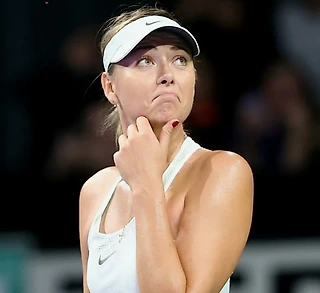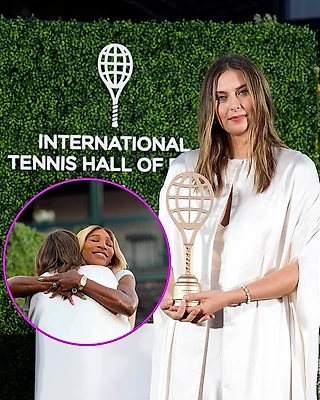CAS: Апелляция Марии - часть 29
В эту серию постов буду выставлять подробности апелляции Марии против решения Трибунала ИТФ.
Рекомендую прочитать статью ниже. Она лучший обзор всех событий, связанных с мельдониумом.
Автор Энди Браун знаком Вам, я выставлял много раз его статьи.
Он сделал отличную работу, спасибо ему большое!
Но статья очень длинная, а если будем иметь в виду и все приложения через ссылки, которые она содержит, тогда ее объем действительно огромный.
Поэтому я выставил ниже только некоторые короткие вырезки, самые главные, по- моему, чтобы Вам было легче получить идею, о чем идет речь.
Автор ставит много важных вопросов, обвиняет ВАДА, что создало большие проблемы спортсменам и спортивным организациям своими действиями и решениями о мельдонии.
Дает примеры, как невинные спортсмены (российские и другие) из-за ВАДА и мельдония не смогли участвовать в Рио на ОИ.
Прямо говорит:
""
Если Россия думает, что пахнет заговором, то ВАДА должно ответить на такие вопросы:
• почему ВАДА приняло, по-видимому, без сомнения, исследование, которое было подготовлено по поручению американского "US sport";
• думало ли ВАДА, что запрет мельдония может создать впечатление, что это был целенаправленный шаг, чтобы предотвратить спортсменов из Восточной Европы участвовать в ОИ в Рио в 2016 году;
• осуществило ли ВАДА независимую проверку исследования, которое заказало американское PCC;
• почему ВАДА не включило фирменное наименование препарата (Милдронат) в список запрещенных, несмотря на факт, что исследование, которое ВАДА использовала, чтобы забанить этот препарат, использует этот бренд.
• почему ВАДА не включило фирменное наименование препарата (Милдронат) в список запрещенных, несмотря на слова научного директора ВАДА, сказаные в 2015 году, что включение названия бренда было «полезно» для спортсменов.
• почему ВАДА не обеспечило обновления о запрете препарата, на местных языках в конкретной области (Восточная Европа).
""
Думаю, будете довольны, когда прочитаете эту статью.
Meldonium madness, Russia, Sharapova & Rio 2016
Andy Brown @journoAndy
In March, the world’s attention was drawn to a medication little-known outside of eastern Europe, when tennis superstar Maria Sharapova tested positive for meldonium. Few people had heard of the substance, which is manufactured in Latvia under the brand name ‘mildronate’ for use almost exclusively in eastern Europe – specifically in Russia, where it is available over the counter.
Because of this, its inclusion on the World Anti-Doping Agency’s (WADA) 2016 Prohibited List has polarised opinion. Supporters of its ban argue that using scientific evidence, it can be argued that meldonium is performance-enhancing and is being abused in sport. Equally, it can be argued that such scientific evidence is flawed, and meldonium protects against heart attacks.
Due to uncertainty over the excretion times for meldonium, anti-doping organisations (ADOs) have faced confusion over how to sanction athletes who tested positive for meldonium in 2016, despite having stopped taking the drug before the 2016 Prohibited List came into effect. In an extreme case, this has led to a US athlete being allowed to take part in the Rio 2016 Olympics, whilst his Russian team mate was excluded, despite them both testing positive as a result of being given meldonium by their team doctor prior to 2016.
Grindeks, the manufacturer of mildronate, has argued that as the substance is not performance-enhancing, it should never have been put onto the Prohibited List in the first place, as its use is designed to protect the heart when pushed to capacity. It is understood that some doctors prescribed meldonium to athletes to protect the heart from the effects of strenuous exercise. As the collapse of footballer Fabrice Muamba and others illustrates, it could be argued that such protection is a legitimate medical aim.
...............................................
Meldonium was added to WADA’s Monitoring Programme in September 2014, and was added to the 2016 Prohibited List a year later. It was added following research commissioned by the Partnership for Clean Competition (PCC), which found a ‘growing body of evidence (black market products and athlete statements) concerning its misuse in sport’. The PCC-commissioned research does support the idea that meldonium is performance-enhancing, which would clear the first hurdle of WADA’s three categories for inclusion on the Prohibited List.
----------------------------------------------
The PCC commissioned its research into meldonium shortly before signing a partnership with WADA at the end of April 2015. As this statement announcing the partnership reveals, the PCC is ‘an innovative research collaborative founded in 2008 as a 501(c)(3) non-profit public charity by the United States Olympic Committee, United States Anti-Doping Agency, Major League Baseball and the National Football League’.
----------------------------------------------
Meldonium (мельдоний) is included on Russia’s Vital and Essential Drugs List, 2012, as supplied to the World Health Organisation (WHO), which is designed to increase its accessibility to the general population for health maintenance purposes. It is registered for public use in Latvia, Russia, Ukraine, Georgia, Kazakhstan, Azerbaijan, Belarus, Uzbekistan, Moldova, and Kyrgyzstan. In Russia alone, between 30 and 40 million mildronate capsules are taken each year, with sales of over 2.3 billion Russian rubles (€33.3 million) in 2008. Given that meldonium is largely used in eastern Europe and is largely known through the local names for the Grindeks brand mildronate (Russian = Милдронат), it is perhaps no surprise that so many eastern European athletes were caught out by its inclusion on the 2016 Prohibited List.
Finding ‘mildronate’ on the Prohibited List is impossible even in English – a search for the brand name turns up zero results. Only athletes searching for the active chemical ingredient in English, meldonium, would have been presented with a result by WADA’s own search system, which is not available in Russian.
----------------------------------------------
If Russia smells a conspiracy, then WADA has questions to answer on:
• why it accepted, apparently without question, research that appears to have been commissioned by US sport;
• whether it considered that banning meldonium could create the perception that this was a targeted move to prevent athletes from eastern Europe competing at the Rio 2016 Olympics;
• whether it independently verified the PCC-commissioned research;
• why it failed to include the drug’s brand name (mildronate) on the Prohibited List, despite the research it relied upon to ban that drug using that brand name.
• why it failed to include the drug’s brand name (mildronate) on the Prohibited List, despite WADA’s Scientific Director concluding in 2015 that inclusion of the brand name was ‘useful’ to athletes.
• why it failed to provide local language updates about a ban on a drug used in a specific area (Eastern Europe).
----------------------------------------------
The second clarification, issued on 30 June, issued updated guidance regarding the concentration of meldonium in athlete samples depending on the date when the sample was collected. It confirmed that from 1 March (and up until 30 September) 2016, cases with a low concentration of meldonium found in an athlete’s sample (less than 1 μg /mL) are compatible with a no fault finding.
However, interestingly, it also advised that athletes who reported concentrations of meldonium under 5 μg /mL in tests taken between 1 January and 29 February should be considered not at fault for their ADRV. ‘In the absence of other evidence of use on or after 1 January 2016, a finding of no fault may be made’, reads the Guidance. ‘In the absence of other evidence of use after 29 September 2015, no disqualification of results’.
This appears to shift the date of WADA’s prohibition on taking meldonium to before it became prohibited on 1 January 2016. It also appears that neither clarification was issued in Russian.
---------------------------------------------
Innocent athletes miss Rio
Unfortunately, the proximity of WADA’s guidance on meldonium to the Rio 2016 Olympics has meant that some athletes who appear to have stopped taking the drug before it was banned have missed out on the Games. In other cases, athletes who have been found to bear no fault for ingestion of meldonium have been prevented from taking part in the Olympics.
--------------------------------------------
The Russian double whammy
When the athletes reporting AAFs for meldonium were Russian, ADOs were hit with a double whammy. Not only did they have to deal with two sets of WADA guidance on how to deal with meldonium positives, they were pitched a curveball by the IOC on 24 July, just 12 days before the Olympics. ‘The ROC [Russian Olympic Committee] is not allowed to enter any athlete for the Olympic Games Rio 2016 who has ever been sanctioned for doping, even if he or she has served the sanction’, read point three of its conditions for the entry of Russian athletes to the Rio Olympics.
As could perhaps be expected, this caused chaos. Due to WADA’s changing guidance on how to deal with meldonium positives, many federations were still uncertain on how to proceed with meldonium cases at this point. When the athletes in question were Russian, the IOC conditions for Russian Rio 2016 entry naturally led to caution.
-------------------------------------------
This once again led to more apparently innocent athletes being excluded from the Rio Olympics. Alexander Markin was excluded from the Russian volleyball team at a very late stage. Google’s cache of the Russian team on the Rio 2016 official site includes him as a team member, however the actual page does not.
-------------------------------------------
However, Maxwell Holt was a member of the US volleyball team that beat Russia to secure a bronze at the Rio 2016 Olympics. He tested positive for meldonium through a sample given on 10 June, much later than Markin’s 6 January AAF, but the US Anti-Doping Agency (USADA) accepted his explanation that he was given the drug by his club, Dynamo Moscow.
------------------------------------------
In case you haven’t already guessed, Markin and Holt play for the same team, Dynamo Moscow. One was allowed to compete at the Rio 2016 Olympics and one was not, despite both having been given meldonium at the same time by their team doctor.
------------------------------------------
Sharapova relief
In another decision that has polarised opinion, the CAS reduced a two-year ban issued by the International Tennis Federation (ITF) on 6 June, after she tested positive for meldonium at the Australian Open on 26 January, to 15 months. The CAS panel found that Sharapova bore no significant fault for her positive test for meldonium
-----------------------------------------
The ITF attempted to assert that ‘several scientists’ including the inventor of the drug, had claimed that it improved athlete endurance and performance, mentioning that it is ‘specifically marketed’ as a drug that increases exercise capacity. However, the panel did not need to examine whether the scientific data backs this claim up, as Sharapova was able to prove that her reasons for taking mildronate were medical and were not to enhance her performance. Details are available in the ‘Statements of Facts’ document reproduced above.
----------------------------------------
A perfect storm
Unfortunately, it appears that athletes such as Sharapova and Markin have been on the receiving end of a perfect storm.
----------------------------------------
WADA says that its List Committee decided to add meldonium to the List due to ‘evidence of clear abuse of the substance while it was on the List’s 2015 Monitoring Program’.
However, it appears that WADA conducted no research into how long meldonium remains in the body.
----------------------------------------
This led to the situation that many athletes reported an AAF for meldonium despite having stopped taking it before it became prohibited.
----------------------------------------
WADA no doubt thought it was doing the right thing by advising that athletes who reported low concentrations of meldonium should not be considered at fault for their ADRV. However as its Guidance mandated that an ADRV should be issued in such cases, this – combined with the IOC decision – paradoxically meant that in practice, Russians who had taken meldonium before it became prohibited should be excluded from Rio.
---------------------------------------
Politicisation of anti-doping
The IOC was placed in a difficult position by WADA’s recommendation that it should exclude all Russian athletes from the Rio 2016 Olympics. If it had done so, it could have faced lawsuits from athletes legitimately arguing that they had done nothing wrong – especially those Russian athletes based overseas.
---------------------------------------
Regarding meldonium, the problematic term is the third IOC condition, which bans any Russian previously sanctioned for doping from Rio. There was no explanation as to why this condition, which appears to be a direct contradiction of the legal principle known as Ne bis in idem (not being punished twice for the same offence), is necessary.
---------------------------------------
However the IOC was under pressure from WADA to ban Russia, despite the fact that any legal comeback from that decision would not fall on WADA, but on the IOC. This is perhaps why some within the IOC, such as Sergey Bubka and Gerardo Werthein, have called for reform of WADA. It does not help WADA’s case that it appears to have abdicated all responsibility for failure to tackle systemic Russian doping, despite evidence of its failures.
---------------------------------------
Lessons to be learned from meldonium madness
---------------------------------------
In terms of lessons learned, it is unlikely that WADA will add a substance to the Prohibited List again without doing more work on excretion times. It is also suggested that the criteria for inclusion on the Prohibited List may need to be strengthened if ADOs are to be confident that they can proceed with an ADRV with certainty. If WADA is placing a substance onto the List because it has found widespread abuse of that substance in sport without evidence that substance can enhance performance, then ADOs need to know that before they put results management into progress.
---------------------------------------
As one of tennis’ highest earners, Sharapova had the money to make her case, and was supported by an expensive legal team comprising of respected sports lawyers including John Haggerty, Howard Jacobs and Mike Morgan of Morgan Sports Law LLP. Other athletes may not be able to afford this luxury and we may never know just how many had legitimate reasons for taking meldonium. On 31 December 2015 these athletes weren’t cheats and today they are. Is the objective to stop people using the drug or catch them using it? Have the authorities done enough to affect behavioural change to go alongside changes in the rules?
--------------------------------------
Why were similar steps not taken to specifically warn athletes about meldonium, given that WADA was aware of its widespread use in eastern Europe and Russia? Critics are likely to allege that WADA deliberately kept quiet about the change in order to ensnare eastern European athletes. In each of the many cases, did ADOs allow themselves the time and opportunity to fully understand the circumstances behind an athlete testing positive? To work out if they are dealing with a cheat? As the evidence above illustrates, it appears that this has not always worked as it should.
-------------------------------------
Unfortunately, a perfect storm has manifested itself to exclude innocent athletes from the Rio 2016 Olympics. Only time will tell as to whether we will see who is culpable for that examined in detail by sport’s courts. Unfortunately, the meldonium madness has led to many innocent athletes being denied their Rio dreams.
http://www.sportsintegrityinitiative.com/meldonium-madness-russia-sharapova-rio-2016/
(продолжение следует)
Предыдущие посты на эту тему Вы можете найти здесь:
Книга «Наша Маша» - Глава «Трибунал: Защита Марии»
https://www.sports.ru/tennis/blogs/922491.html
>










В полном тексте была и другая важная тема: какими именно мотивами может руководствоваться WADA, чтобы запретить препарат: его допинговые свойства это не единственное основание, может быть и запрет препарата на основании "заботы о здоровье спортсмена". Вот это тоже хороший пассаж: то есть мы тебя на весь мир объявим допингистом, дисквалифицируем, лишим заработка, но сделаем это не потому, что ты нарушил моральные и этические нормы спорта и пытался получить незаконное преимущество, а потому что мы "заботимся о тебе".
Очень важный моральный вопрос: если никто не доказал, что милдронат или любой другой препарат (а таких случаев немало) не является допингом, обладает ли WADA и Трибуналы Федераций моральным правом называть хоть кого-то, кто использовал эти препараты - допингистами. Тем более умышленными. Это как если бы прокурор пришёл в суд и требовал для обвиняемого наказания за убийство, а когда судья спрашивает кого он убил прокурор отвечает: да он никого вообще-то не убивал, просто нам нужно кого-то за что-то посадить, вот давайте его за убийство посадим, или за что-то другое.
Единственное, я вот так и не понял что это за "PCC"? Насколько эта "контора" может считаться независимой и авторитетной. Откуда её бюджет. Если её бюджет формируют фарм-корпорации (прямо или косвенно) то, что можно говорить о "независимости". О их квалификации там был интересный пассаж со ссылками на два исследования, которые никак нельзя считать авторитетными, но про них Денни уже раньше выставлял информацию, так что повторяться не будем.
То есть это 100% американская организация. Ее оформили как благотворительной фирмой, чтобы не платит налоги, и легче получать финансирование.
"PCC" стала партнером ВАДА в апреле 2015 года.
Знаю и другие случаи.
Вы правы, к сожаленью, такие случаи среди спортсменов становятся больше и больше.
Нельзя сказать, что спортивные организации не применяют меры для здоровья спортсменов, но нельзя сказать, что сделали многое.
Я планировал писать в блоге об этом и в 2013 году начал накапливать инфо, но потом неожиданно моя жизнь вошла в черную полосу и не смог осуществить ничего от спланированного.
Add comment
By Nick Butler Monday, 24 October 2016
Whistleblowing couple Yuliya and Vitaly Stepanov have been provided with a range of support measures by the International Olympic Committee (IOC) following a meeting with the organisation’s President Thomas Bach, insidethegames can reveal.
As a result of discussions, former Russian Anti-Doping Agency (RUSADA) employee Vitaly will be providing a consultancy service to the IOC on all aspects of doping control and the protection of clean athletes.
Middle distance runner Yuliya will also be receiving a scholarship to be used for her training.
The husband and wife duo have taken up residence at an unknown location in the United States due to having to flee Russia after they provided evidence of state-sponsored doping in 2014.
http://www.insidethegames.biz/articles/1042950/exclusive-ioc-provide-stepanovs-with-consultancy-work-and-training-grant-following-meeting-with-bach
Вот есть такая ситуация: в последнее время очень много спортсменов умирает от сердечных приступов, либо во время соревнований, либо во время тренировок. Я знаю несколько таких случаев. В 2015 году во время тренировки умерла теннисистка Виолетта Дегтярёва ( http://www.monway.ru/886-tennisistka-violetta-degtyareva-prichina-smerti/ ), ещё ранее, несколько лет назад, прямо во время матча умер молодой хоккеист Алексей Черепанов (он есть в Википедиа) , он играл в России кажется за "Авангард" Омск. У него было больное сердце, а препарат, который ему выписали врачи , незадолго до смерти был включён в список запрещённых. Тогда много говорили, что не было никаких доказательств, что тот препарат является допингом.
Но это только то, что стало широко известно, хотя я не сильно слежу за новостями, но ведь таких случаев гораздо больше. И спортсмены умирают не только в России, но и в других странах. А сколько спортсменов от таких запретов теряют возможность работать в будущем и становятся инвалидами в молодом возрасте.
Мне интересно, какая позиция ITF и WTA была по случаю с Дегтярёвой, ведь у неё профессиональный контракт был с WTA. Или им наплевать: померла - так померла. Вообще хоть кто-то в мире интересуется этими вопросами. Чтобы какой-то милдронат объявить допингом так все тут как тут, кучу статей про Машу написали, хотя никто не доказал, что милдронат даёт преимущество, а когда люди умирают - так всем это безразлично. Я не знал эту девушку и никогда не видел как она играет, но возможно она тоже принимала милдронат и перестала его принимать после запрета. Можно это где-то узнать и как-то предать огласке?
https://twitter.com/plavandoski/status/790303375678115840